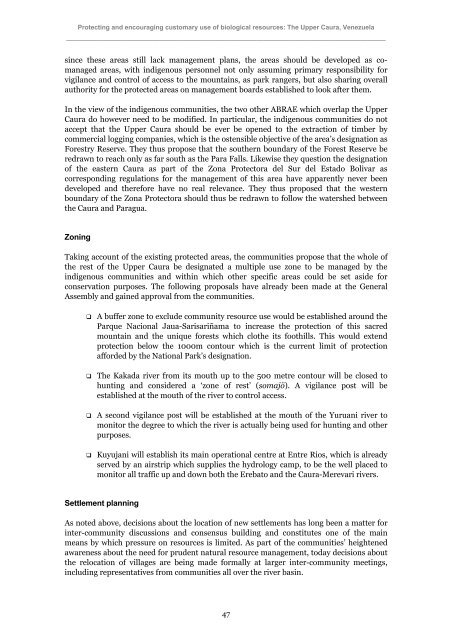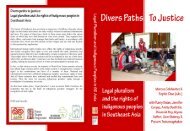The Upper Caura, Venezuela - Forest Peoples Programme
The Upper Caura, Venezuela - Forest Peoples Programme
The Upper Caura, Venezuela - Forest Peoples Programme
Create successful ePaper yourself
Turn your PDF publications into a flip-book with our unique Google optimized e-Paper software.
Protecting and encouraging customary use of biological resources: <strong>The</strong> <strong>Upper</strong> <strong>Caura</strong>, <strong>Venezuela</strong>_________________________________________________________________________________________since these areas still lack management plans, the areas should be developed as comanagedareas, with indigenous personnel not only assuming primary responsibility forvigilance and control of access to the mountains, as park rangers, but also sharing overallauthority for the protected areas on management boards established to look after them.In the view of the indigenous communities, the two other ABRAE which overlap the <strong>Upper</strong><strong>Caura</strong> do however need to be modified. In particular, the indigenous communities do notaccept that the <strong>Upper</strong> <strong>Caura</strong> should be ever be opened to the extraction of timber bycommercial logging companies, which is the ostensible objective of the area’s designation as<strong>Forest</strong>ry Reserve. <strong>The</strong>y thus propose that the southern boundary of the <strong>Forest</strong> Reserve beredrawn to reach only as far south as the Para Falls. Likewise they question the designationof the eastern <strong>Caura</strong> as part of the Zona Protectora del Sur del Estado Bolivar ascorresponding regulations for the management of this area have apparently never beendeveloped and therefore have no real relevance. <strong>The</strong>y thus proposed that the westernboundary of the Zona Protectora should thus be redrawn to follow the watershed betweenthe <strong>Caura</strong> and Paragua.ZoningTaking account of the existing protected areas, the communities propose that the whole ofthe rest of the <strong>Upper</strong> <strong>Caura</strong> be designated a multiple use zone to be managed by theindigenous communities and within which other specific areas could be set aside forconservation purposes. <strong>The</strong> following proposals have already been made at the GeneralAssembly and gained approval from the communities. A buffer zone to exclude community resource use would be established around theParque Nacional Jaua-Sarisariñama to increase the protection of this sacredmountain and the unique forests which clothe its foothills. This would extendprotection below the 1000m contour which is the current limit of protectionafforded by the National Park’s designation. <strong>The</strong> Kakada river from its mouth up to the 500 metre contour will be closed tohunting and considered a ‘zone of rest’ (somajö). A vigilance post will beestablished at the mouth of the river to control access. A second vigilance post will be established at the mouth of the Yuruani river tomonitor the degree to which the river is actually being used for hunting and otherpurposes. Kuyujani will establish its main operational centre at Entre Rios, which is alreadyserved by an airstrip which supplies the hydrology camp, to be the well placed tomonitor all traffic up and down both the Erebato and the <strong>Caura</strong>-Merevari rivers.Settlement planningAs noted above, decisions about the location of new settlements has long been a matter forinter-community discussions and consensus building and constitutes one of the mainmeans by which pressure on resources is limited. As part of the communities’ heightenedawareness about the need for prudent natural resource management, today decisions aboutthe relocation of villages are being made formally at larger inter-community meetings,including representatives from communities all over the river basin.47
















